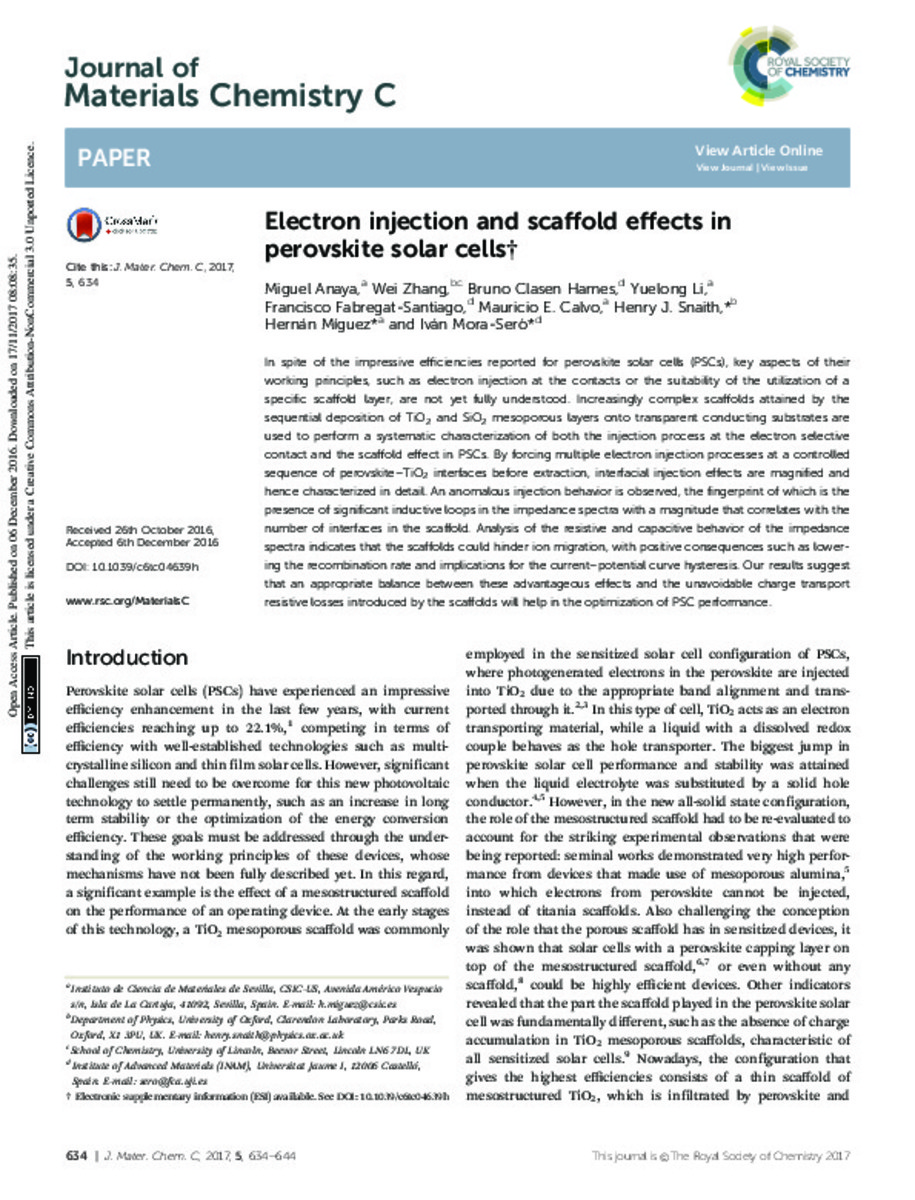Mostrar el registro sencillo del ítem
Electron injection and scaffold effects in perovskite solar cells
| dc.contributor.author | Anaya, Miguel | |
| dc.contributor.author | Zhang, Wei | |
| dc.contributor.author | Clasen Hames, Bruno | |
| dc.contributor.author | Li, Yuelong | |
| dc.contributor.author | Fabregat-Santiago, Francisco | |
| dc.contributor.author | Calvo, Mauricio E. | |
| dc.contributor.author | Snaith, Henry J. | |
| dc.contributor.author | Míguez, Hernán | |
| dc.contributor.author | Mora-Sero, Ivan | |
| dc.date.accessioned | 2017-11-17T08:17:34Z | |
| dc.date.available | 2017-11-17T08:17:34Z | |
| dc.date.issued | 2016-12 | |
| dc.identifier.citation | ANAYA, Miguel, et al. Electron injection and scaffold effects in perovskite solar cells. Journal of Materials Chemistry C, 2017, vol. 5, no 3, p. 634-644. | ca_CA |
| dc.identifier.uri | http://hdl.handle.net/10234/170170 | |
| dc.description.abstract | In spite of the impressive efficiencies reported for perovskite solar cells (PSCs), key aspects of their working principles, such as electron injection at the contacts or the suitability of the utilization of a specific scaffold layer, are not yet fully understood. Increasingly complex scaffolds attained by the sequential deposition of TiO2 and SiO2 mesoporous layers onto transparent conducting substrates are used to perform a systematic characterization of both the injection process at the electron selective contact and the scaffold effect in PSCs. By forcing multiple electron injection processes at a controlled sequence of perovskite–TiO2 interfaces before extraction, interfacial injection effects are magnified and hence characterized in detail. An anomalous injection behavior is observed, the fingerprint of which is the presence of significant inductive loops in the impedance spectra with a magnitude that correlates with the number of interfaces in the scaffold. Analysis of the resistive and capacitive behavior of the impedance spectra indicates that the scaffolds could hinder ion migration, with positive consequences such as lowering the recombination rate and implications for the current–potential curve hysteresis. Our results suggest that an appropriate balance between these advantageous effects and the unavoidable charge transport resistive losses introduced by the scaffolds will help in the optimization of PSC performance. | ca_CA |
| dc.format.extent | 10 p. | ca_CA |
| dc.format.mimetype | application/pdf | ca_CA |
| dc.language.iso | eng | ca_CA |
| dc.publisher | Royal Society of Chemistry | ca_CA |
| dc.rights | © The Royal Society of Chemistry 2017 | ca_CA |
| dc.rights | Atribución 4.0 Internacional | * |
| dc.rights.uri | http://creativecommons.org/licenses/by-sa/4.0/ | * |
| dc.subject | perovskite solar cells | ca_CA |
| dc.subject | electron injection | ca_CA |
| dc.subject | solar cells | ca_CA |
| dc.subject | electrons | ca_CA |
| dc.subject | perovskite | ca_CA |
| dc.subject | solid solutions | ca_CA |
| dc.subject | titanium dioxide | ca_CA |
| dc.title | Electron injection and scaffold effects in perovskite solar cells | ca_CA |
| dc.type | info:eu-repo/semantics/article | ca_CA |
| dc.identifier.doi | http://dx.doi.org/10.1039/C6TC04639H | |
| dc.relation.projectID | European Research Council under the European Union's Seventh Framework Program (FP7/2007-2013)/ERC grant agreement no. 307081 (POLIGHT)) and the Spanish Ministry of Economy and Competitiveness (MAT2014-54852-R and MAT2015-70611-ERC) | ca_CA |
| dc.rights.accessRights | info:eu-repo/semantics/openAccess | ca_CA |
| dc.relation.publisherVersion | http://pubs.rsc.org/en/content/articlehtml/2016/tc/c6tc04639h | ca_CA |
| dc.contributor.funder | Fundación Bancaria Caixa d’Estalvis i Pensions de Barcelona; Conselho Nacional de Desenvolvimento Científico e Tecnológico | ca_CA |
| dc.type.version | info:eu-repo/semantics/publishedVersion | ca_CA |
Ficheros en el ítem
Este ítem aparece en la(s) siguiente(s) colección(ones)
-
FCA_Articles [501]
Articles de publicacions periódiques








